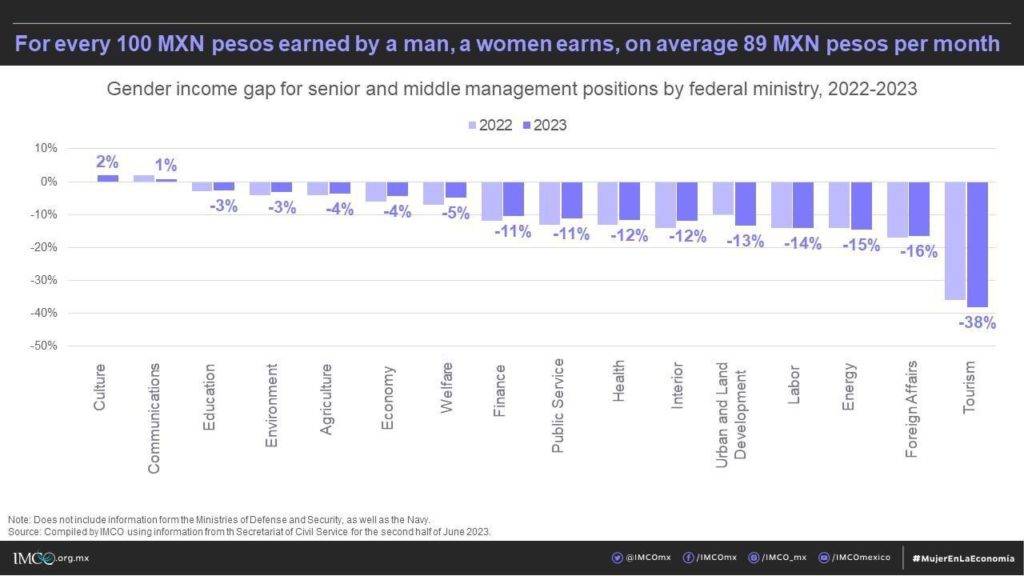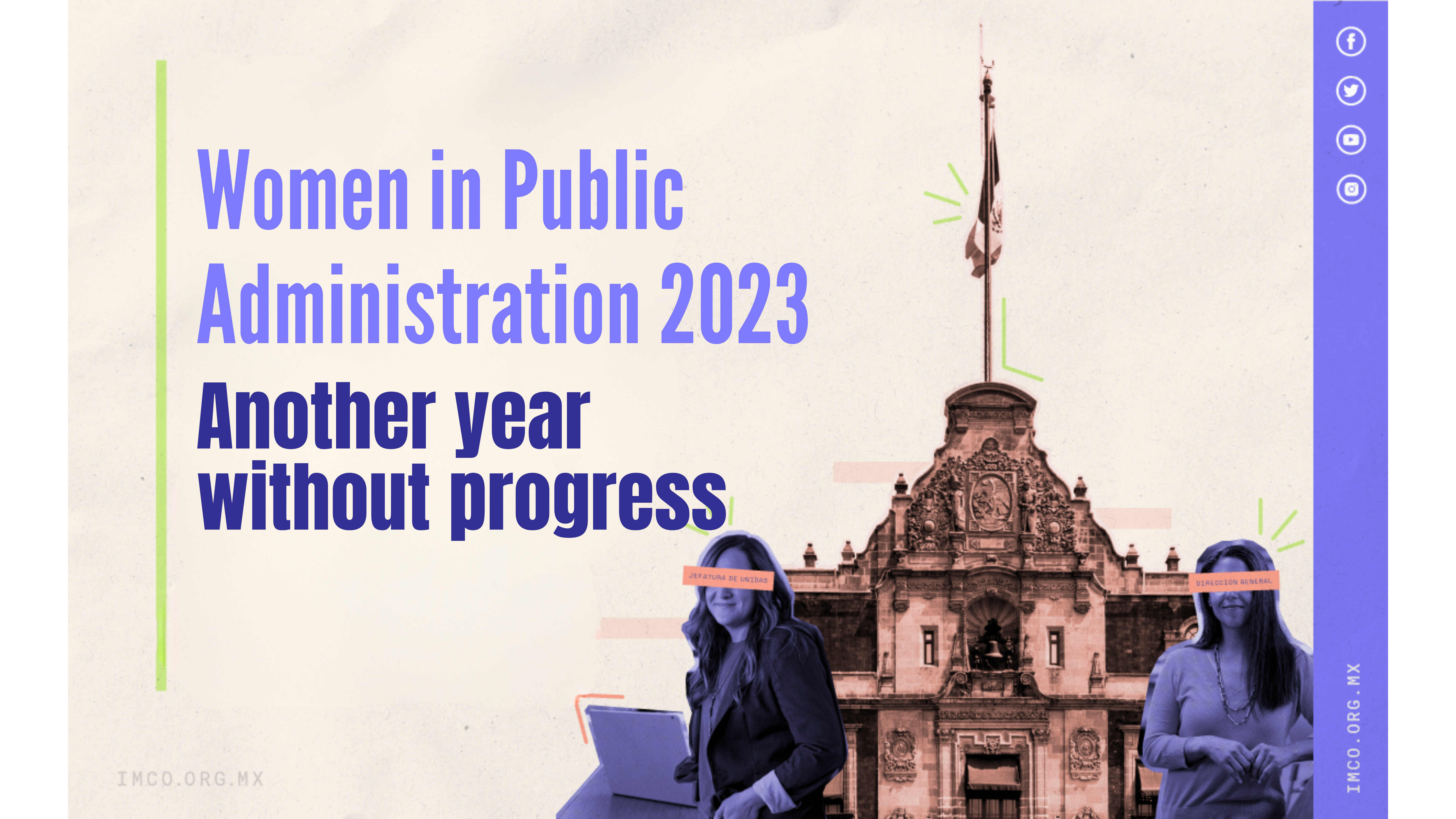Another year without progress for women in the Federal Public Administration
Mexico ranks third with least women representation in top public sector positions in Latin America, trailing behind Guatemala and Brazil. To measure, highlight and monitor gender gaps within federal ministries, the Mexican Institute for Competitiveness (IMCO) analyzed1 the roles and salary tiers of over 168 thousand public officials during the second half of June 2023. Three years after the first edition, gender gaps within ministries remain unchanged.
What positions do women hold within the ministries?
Although female representation is high in entry level positions, it decreases as seniority increases (except for Secretary positions). While women occupy 47% of liaison positions –the lowest hierarchical level– in senior management positions the proportion reduces to 33% (undersecretaries, heads of unit and general directors).

There is gender parity in top positions (secretaries), as half of them are occupied by women: Welfare, Culture, Economy, Education, Energy, Interior, Environment, and Foreign Affairs. However, senior management positions have lower women participation: undersecretaries (30%), heads of unit (28%) and general directors (34%).
1 This study considers 16 out of the 19 Ministries of the federal government, as information from the Ministries of Defense and Security, as well as the Navy is not available in the Transparent Payroll of the Public Service Ministry.
Assessing gender disparities and implementing strategies to bridge the gender gap is crucial for the fostering the necessary conditions that enable women to climb the ladder and remain in leadership positions without facing additional obstacles compared to their male peers.
Has women’s participation changed?
Female representation in ministries has not changed significantly over the past three years. Half of the ministries do not have any female undersecretaries, although women’s participation at this level increased compared to 2022 from 28% to 30%. On the other hand, women's participation in general director positions is on the rise, with a 13% increase compared to 2021. The third- highest leadership position within the ministries -heads of unit- has not registered a comparable increase. Furthermore, it has the lowest female representation.
Regarding middle management positions, the increase of women as deputy directors is worth mentioning as it rose from 40% to 43% between 2022 and 2023. In comparison, area directors and department heads slightly decreased their female participation compared to the previous year by one and two percentage points, respectively.

How is the participation of women in senior management positions?
Senior management positions are the highest-level roles within the ministries –second to the secretary itself. However, this is the tier where women's leadership lags the most. Only 33% of senior leadership positions are held by women, that is equivalent to one out of every three positions. Compared to the previous year, this proportion increased by two percentage points, due to 18 women being appointed between 2022 and 2023.
Ministries showcasing the most substantial representation of women in senior roles include Labor (44%), Culture (43%), and Agriculture (43%). In contrast, the Tourism Ministry lags
significantly with women occupying a mere 4% of such positions. In the latter, there is only one woman occupying a general director position out of 24 senior management positions within the Ministry.
The Education Ministry registered the most significant increase in women's participation, as it rose from 25% to 37%. This increase is attributed to the addition of four women to senior positions, accompanied by a reduction in the total number of positions at this level. However, four Ministries decreased women's participation in senior positions: Urban and Land Development, Tourism, Communications, as well as Labor.

How much do women earn in the ministries?
Salary tiers stipulate the base salary and guaranteed compensation for each position which aim to prevent income disparities among men and women public officials who hold the same level of position within the ministries. Nevertheless, the salary tiers do not eliminate gender income gaps, as they do not counteract the unequal distribution of women in the workforce structure.
The lower participation of women in top positions translates into lower income for women at an aggregate level. The gender income gap in leadership positions is 11%, which increased by three percentage points compared to 2022. In other words, for every 100 Mexican pesos received by a man, a woman receives an average of 89 Mexican pesos in leadership positions within the ministries.
In seven out of the 16 ministries, there is a gender income gap in leadership positions ranging from a 2% advantage in favor of women to a 5% disadvantage, which means they are very close to achieving wage equality. Compared to 2022, there are two ministries –Economy and Welfare– that have reduced their income gap due to an increase in women occupying higher leadership
The Tourism Ministry registers the highest income gap (38%). Once again, this is explained by the low participation of women in higher leadership positions (4%). Finally, the case of the Labor Ministry stands out because, despite having the highest participation of women in higher leadership positions (44%), a 14% income gap persists. While it has a high proportion of women in higher leadership roles, they participate at lower hierarchical levels: general director and department head positions.

Despite progress towards gender equality within ministries, the actions taken have proven insufficient to bring a substantive change in women representation. The most significant progress is observed in ministries that have achieved higher levels of women's participation in leadership positions. On a contrasting note, the ministries with the lowest levels of female representation show less improvement.
The evidence indicates that increasing women's leadership within the public sector is related with the development of more inclusive public policies and increased public spending in areas like education and health, which enriches the discussion on the different priorities and needs that exist between men and women. To achieve this, ministries must not only recognize the prevailing gender gaps within their hierarchical structure but also dive deeper into their underlying causes. To achieve this, IMCO proposes that the Federal Government should:
- Measure and disclose gender gaps on the website of the Public Service Ministry, as well as expand the measurement to the entire Federal Public Administration.
- Use detailed level data of the federal payroll to implement a gender perspective self- diagnosis within government institutions.
- Share good practices for women inclusion among ministries.
- Assess working hours and schedules, especially hybrid work arrangements and for higher- ranked positions within ministries.
This press release is based on a research conducted in Spanish. For further information, please contact us at: sociedad@imco.org.mx

